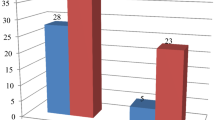Abstract
The term chronic suppurative otitis media (CSOM) refers to middle ear infections lasting more than three months that lead to perforated tympanic membrane. Low socioeconomic strata of the society are more likely to have the disease in developing countries. There have been many studies focusing on the bacterial flora of CSOM, but little is known about the mycological aspects, which have become increasingly important over the last few decades. The present study was aimed to speculate the presence of fungal flora responsible for the cases of CSOM among patients who attended the Ear, Nose, and Throat Department of our hospital a tertiary care center. This retrospective study was conducted in a tertiary care centre after taking the approval of the protocol review committee and institutional ethics committee. Total 100 Patients of chronic otitis media were included with no history using ear drops for last one week and using two sterile swab without touching the external auditory canal, discharge was taken from middle ear and placed in sterile container and sent for potassium hydroxide (KOH) mount and observed. The age ranged from 18 months to 87 years and the mean age was 37.27+/- 12.59 years. The study population of male is 42 (41.6%) and female is 59 (58.4%). Distribution of KOH positivity observed for 33 (32.7%) and KOH negative for the study population of 68 (67.3%). When antibacterial treatment does not seem to relieve persistent otorrhea, otologists should suspect mycotic otitis media probable cause.


Similar content being viewed by others
Data Availability
The data used in this study was not used/published in any other publications.
Code Availability
The data was compiled and analyzed using IBM SPSS STATISTICS version 22.
References
Pradhan B, Tuladhar NR, Amatya RM (2003) Prevalence of otomycosis in outpatient department of otolaryngology in Tribhuvan University Teaching Hospital, Kathmandu, Nepal. Annals of Otology, Rhinology & Laryngology. Apr;112(4):384-7
Talwar P, Chakrabarti A, Kaur P, Pahwa RK, Mittal A, Mehra YN (1988 Oct) Fungal infections of ear with special reference to chronic suppurative otitis media. Mycopathologia 104:47–50
Pahwa VK, Chamiyal PC, Suri PN (1983 Mar) Mycological study in otomycosis. Indian J Med Res 77:334–338
Nowrozi H, Arabi FD, Mehraban HG, Tavakoli A, Ghooshchi G (2014 Jan) Mycological and clinical study of otomycosis in Tehran, Iran. Bull Environ Pharmacol Life Sci 3(2):29–31
Khasanov US, Khudjanov SK, Djuraev JA, Botirov AJ, Features of mycological, and clinical studies of otomycosis. The American Journal of Medical Sciences and Pharmaceutical Research. 2022 Jan29;4(01):40–59
Clinical Microbiology Procedure Handbook Vol. I & II, Chief in editor H.D. Isenberg, Albert Einstein College of Medicine, New York,Publisher ASM (American Society for Microbiology), Washington DC
Nipa KK, Kamal AH, Imtiaj A (2020) Prevalence and clinicomycological studies of otomycosis: a review. J Bio-Science 28:121–135
SUH, MK, HA GY (1999). A clinical and mycological study of otomycosis. Korean Journal of Medical Mycology. 15–20
Barati B, Okhovvat SA, Goljanian A, Omrani M (2011 Dec) Otomycosis in central Iran: a clinical and mycological study. Iran red crescent Med J 13(12):873
Munguia R, Daniel SJ Ototopical antifungals and otomycosis: a review. International journal of pediatric otorhinolaryngology. 2008 Apr 1;72(4):453-9
Talwar P, Chakrabarti A, Kaur P, Pahwa RK, Mittal A, Mehra YN (1988) Fungal infections of ear with special reference to chronic suppurative otitis media. Mycopathologia 104:47–50
Pontes ZB, Silva AD, Lima Ede O, Guerra Mde H, Oliveira NM, CarvalhoMde F et al (2009) Otomycosis: a retrospective study. Braz J Otorhinolaryngol 75:367–370
Chander J, Maini S, Subrahmanyan S, Handa A (1996) Otomycosis – a clinico-mycological study and efficacy of mercurochrome in its treatment. Mycopathologia 135:9–12
Funding
The authors have no relevant financial or non financial interest to disclose.
Author information
Authors and Affiliations
Contributions
All authors contributed to the study conception and design. Material preparation, data collection and analysis were performed by Dr. Santosh U.P, Dr. H. jemimaparveen, Dr. Arfan Nasser, Dr. Sri Vaibhava V, Dr. Ashwini Kuruwatti. The first draft of the manuscript was written by Dr. H. Jemimaparveen and all authors commented on previous versions of the manuscript. All authors read and approved the final manuscript.
Corresponding author
Ethics declarations
Conflict of Interest
The Authors declare that there is no conflict of interest.
Ethics Approval
The study was done after approval of the Institutional Ethics committee from JJM Medical College, Davangere, Karnataka, India in accordance with ethical standards of the institutional and/or national research committee and with the 1964 Helsinki declaration and its later amendments or comparable ethical standards.
Consent to Participate
Written informed consent was taken from all the patient.
Consent for Publication
All authors have reviewed the manuscript and approved the version to be published.
Additional information
Publisher’s Note
Springer Nature remains neutral with regard to jurisdictional claims in published maps and institutional affiliations.
Rights and permissions
Springer Nature or its licensor (e.g. a society or other partner) holds exclusive rights to this article under a publishing agreement with the author(s) or other rightsholder(s); author self-archiving of the accepted manuscript version of this article is solely governed by the terms of such publishing agreement and applicable law.
About this article
Cite this article
U.P., S., Parveen, H.J., Nasser, A. et al. Incidence of KOH Positive Elements in Chronic Discharging Ear –A Retrospective Study. Indian J Otolaryngol Head Neck Surg 75, 2777–2780 (2023). https://doi.org/10.1007/s12070-023-03864-5
Received:
Accepted:
Published:
Issue Date:
DOI: https://doi.org/10.1007/s12070-023-03864-5




